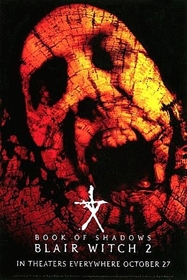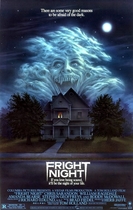Our editor-in-chief Nate Yapp is proud to have contributed to the new book Hidden Horror: A Celebration of 101 Underrated and Overlooked Fright Flicks, edited by Aaron Christensen. Another contributors include Anthony Timpone, B.J. Colangelo, Dave Alexander, Classic-Horror.com's own Robert C. Ring and John W. Bowen. Pick up a copy today from Amazon.com!
Blair Witch 2: Book of Shadows (2000)
I was in the initially small but increasingly vocal minority who didn't care much for the first Blair Witch film. Although at least some Blair Witch Project (BWP) advocates say otherwise, it's hard for me to believe that those who champion the film (the portion of them who weren't paid by Haxan and/or Artisan to say they enjoyed it) aren't doing so for mainly political reasons which amount to being not only anti what they consider teen-oriented horror (but which may just be a function of their aging), as if aiming for a teen audience is anything new in the genre, and anti-Hollywood and big budget films in general. It's as if the first film functioned as an ideological banner in a war not dissimilar to the punk rejection of progressive and corporate rock in the late 70's/early 80's-amateurs and film school students had a newfound hope-they didn't have to produce quality to achieve popularity and acceptance, just own a camera and be able to find the "record" button.
In other words, it was hard for me to believe that anyone actually thought the first film was a good film. Or if they did think that, it was hard for me to believe that they were serious horror fans-that is, fans of the genre as the genre and not just fans of the elements that they consider the criteria for a good film, whether the film happens to be horror or not. I just didn't find a bunch of screaming and whining combined with bad photography, stickmen and rocks to be something that makes a good film, horror or not.
Apparently, Blair Witch 2 (BW2) director Joe Berlinger and scripter Dick Beebe agree with me to an extent, as Blair Witch 2 opens primarily with a mockumentary style similar to the opening of its predecessor, and fictionally set in the same locale of Burkittsville, Maryland, but this time, the mockumentary is making fun of BWP and the Beatlemania-styled hysteria that followed it. For instance, we see an interview with an older housewife only too happy to sell rocks from her garden to tourists. She doesn't understand why someone would want them, of course, but neither do the rest of us who didn't fall for BWP.
Keeping a similar style to BWP, we're introduced to Jeffrey Donovan, a Burkittsville youth who had a troubled past, including a stint in the local looney-bin. Like most loonies, he's now trying to make a living by selling stuff on the Internet, including auctioning stolen goods on Ebay. More importantly, for our purposes, he's also selling Blair Witch "artifacts" and organizing a "Blair Witch Hunt"-a guided tour of sites important to the film. The premise of BW2 is that he actually gets four suckers to sign up for the tour-Kim, a poseur-like "Goth," Erica, an equally poseur-like Wiccan, and a neurotic-seeming couple, Tristine and Stephen, who are supposedly researching a book, "Blair Witch: History or Hysteria?"
The four head out to the woods, setting camp in the ruins of Rustin Parr's place (one of the people we hear a psycho story about in BWP). As an example of the difference between the two films, one of the first "weird" things to happen is the presence of the tree in the middle of the Parr foundation. The tree is far creepier than anything in BWP, save for BWP's ending. It is certainly spookier than any piles of rocks or stickmen, which would be easily explainable under a number of scenarios, unlike the obviously ancient tree, which is inexplicable even if you didn't know it wasn't there the day before. It's as if Berlinger and Beebe are trumping BWP directors and writers Daniel Myrick and Eduardo Sanchez with a flick of their wrists, saying, "if you want to make a creepy film in the woods requiring a fair amount of imagination instead of graphic, straightforward violence, this is how you do it."
But BW2 isn't just about a tree in the middle of a house's foundation. Much odder things happen. As BW2 progresses, it gets better and better, and creepier and more surreal, slowly building to a climax that lasts for at least an hour.
One brilliant move by Berlinger and Beebe is that most of BW2 is non-sequential. Interspersed with our main story are scenes showing Jeffrey's background and scenes showing where our characters are going to end up. None of the jumps out of sequence are explained-you have to figure it out for yourself, at least until it all comes together in the film's climax. Even the principle action is non-sequential, aided by the introduction of the videotape machines (an ingenious and self-referential device for this film) and BW2 plays largely on an unsureness of what is real (also self-referential), realizing the idea in a way that should be the wet dream of any champions of the many-worlds interpretation of quantum mechanics.
A lot of the success is attributable to Berlinger's fine direction and Beebe's excellent script, plus the great performances by the cast, who are just as skilled in suggesting different shades of their characters in a many worlds interpretation. BW2 is a marvel to look at-the cinematography is varied and always interesting, the effects are as good as just about anything in the House on Haunted Hill remake (which Beebe also scripted), and there is neither a complete absence of blood and gore nor is it obvious and in-your-face in the way that many of the BWP lovers detest so much. BW2 is really a well-balanced gem of a film that fans of any genre should enjoy. It's certainly gets my award for the best sequel relative to its precursor.








